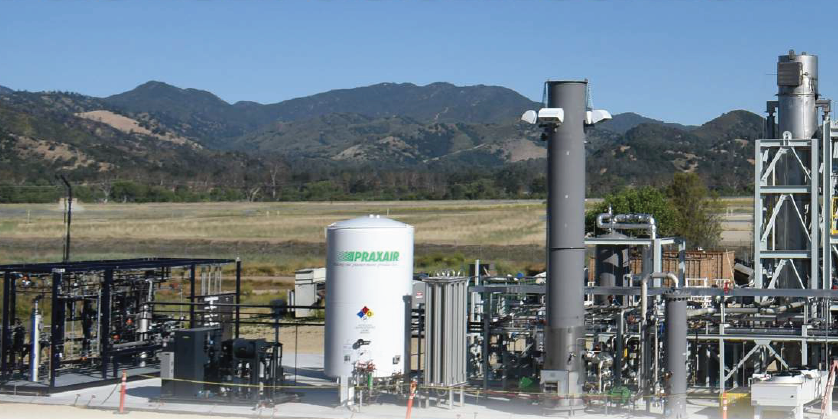The Department of Defense (DoD) has charged the service branches with the mission of improving their use of energy and reducing energy-related emissions or byproducts on military bases [1]. Relatedly, the production of municipal solid waste (MSW) at military installations is an ever-present economic and logistical burden that DoD is seeking to mitigate. Hauling waste from often remote locations is expensive and creates unnecessary risk for military personnel (especially in forward operating theaters). Key to meeting both goals is the application of novel technological solutions. One particularly beneficial example is “waste-to-energy” systems, which use trash, MSW, and other waste-related feedstocks to produce electricity and/or fuels. DoD has been interested in fostering the development of such systems since at least 2010 [2,3].
The U.S. Army is helping meet DoD’s energy and waste-related installation goals at U.S. Army Garrison Fort Hunter Liggett, which is one of the U.S. Army’s 17 Net Zero Initiative pilot installations [4]. There, through a grant awarded by DoD’s environmental technology demonstration and validation program (the Environmental Security Technology Certification Program), the Army has established a facility that processes post-recycled waste to produce energy and fuel without the use of combustion. This facility, known as a gasifier, was built and installed by Sierra Energy. The facility heats up waste feedstocks to approximately 4,000 degrees Fahrenheit. This breaks down the feedstock to the molecular level. Organic material is converted into an energy-dense synthesis gas (syngas) while inorganic materials are transformed into non-leaching stone. The syngas can be used to power a generator to create electricity, or further refined into a diesel fuel. The stone is salable as construction aggregate, road base, or cement clinker, potentially providing DoD with additional revenue to defray costs. The Environmental Protection Agency has also certified that the stone is non-leaching and environmentally safe for use [5].
The gasifier plant at U.S. Army Garrison Fort Hunter Liggett is a modification of traditional gasifier and/or blast furnace technology. Sierra Energy’s key innovation over the state-of-the-art is a process where steam and purified oxygen are injected into the gasifier vessel at supersonic rates [6]. The carbon in the waste chemically reacts with the steam and oxygen, raising the temperatures in the gasifier. The synthesis gas exits the top of the gasifier and is heated in a piece of equipment known as a polisher, which breaks apart any long-chain hydrocarbons in the gas. The syngas is then cooled in a heat exchanger. The system is designed to operate continuously, as long as waste is available around the clock.
Due to the extremely high operating temperature, the system is suitable for all waste types except radioactive material. If metals or rocks get into the gasifier, for example, they will simply melt and be tapped out at the bottom, similar to the way slag is recovered from a blast furnace. Plastics, tires, oily rags, electronic waste, and medical waste all make excellent fuel for the system. This ability to take mixed waste is suitable for use on DoD installations. This may be particularly true in areas where sorting waste streams may not feasible.
Since its start-up in December 2017, the gasifier at U.S. Army Garrison Fort Hunter Liggett is capable of handling up to 20 metric tons per day (mtpd) of waste. An attached generator will utilize the syngas to produce electricity, which is then fed into the Pacific Gas and Electric grid. If optimized to exclusively generate electricity, a 20 mtpd gasifier can produce more than 1 megawatt hour from a feedstock with high carbon content.
Simultaneously eliminating waste in a pollution-free manner and generating substantial amounts of installation power may aid DoD in making significant progress towards meeting its operational energy goals [3]. “Sierra Energy’s gasification unit plays directly into our net-zero waste program and also benefits our net-zero energy program,” said Director of Public Works at Fort Hunter Liggett Greg Vallery. “We also think of it as our part of being a good steward for the environment.”
References
1. U.S. Department of Defense. (2016, March 16). DoD Instruction Number 4170.11,
Change 1: Installation Energy Management. Office of the Under Secretary of Defense for Acquisition, Technology and Logistics (AT&L).
2. U.S. Department of Defense. (2010, August 26). Department of Defense Strategic Sustainability
Performance Plan: FY2010 (Public Version). Office of the Under Secretary of Defense for Acquisition, Technology and Logistics (AT&L).
3. U.S. Department of Defense. (2016). Department of Defense 2016 Operational Energy Strategy. Office of the Assistant Secretary of Defense for Energy, Installations and Environment.
4. U.S. Army. (2017). Army Net Zero. Retrieved from http://www.asaie.army.mil/Public/ES/
netzero/
5. Sierra Energy. (2018, January 3). Webpage, “Inert Stone Products.” Accessed January 3, 2018. Retrieved from http://www.sierraenergy. com/technology/knowledge-base/gasifier-outputs/inert-stone-products/
6. Trninić, M., Stojiljković, D., Jovović, A., Jankes, G. (2016). Biomass gasification technology: The state of the art overview.” 2016 4th International Symposium on Environmental Friendly Energies and Applications (EFEA). doi: 10.1109/EFEA.2016.7748797


